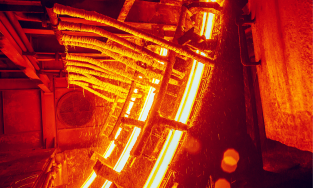Stainless steel, renowned for its exceptional resistance to corrosion and heat, undergoes a complex manufacturing process to achieve its remarkable properties. From melting the raw materials to cutting and finishing, let’s explore the intriguing journey of creating stainless steel.
Melting and Casting:
Basic elements like iron ore, chromium, silicon, nickel, and others are melted together in electric furnaces.
The molten steel is then cast into semi-finished forms such as blooms, billets, slabs, rods, and tube rounds.

Forming:
Semi-finished steel goes through forming operations, starting with hot rolling, where huge rolls shape the steel.
Blooms and billets transform into bars and wires, while slabs become plate, strip, and sheet in various dimensions.

Heat Treatment:
Most stainless steels require annealing, a heat treatment to relieve internal stresses and soften the metal.
Age hardening, a precise heat treatment process, is used for specific steels to achieve higher strength and toughness.
Descaling:
Annealing causes a scale or build-up to form on the steel, which is removed through pickling or electrocleaning processes.
Different steel types undergo annealing and descaling at various stages of the manufacturing process.
Cutting:
Mechanical cutting methods, such as shearing, blanking, and nibbling, help obtain the desired shape and size.
Flame cutting and plasma jet cutting are alternative methods used for precise and efficient cutting.

Finishing:
Surface finish is crucial, affecting appearance, corrosion resistance, and application requirements.
Various finishing methods like polishing, grinding, buffing, and tumbling are employed to achieve different surface qualities.
Manufacturing at the Fabricator or End User:
Once packed and shipped, stainless steel undergoes further shaping, heat treating, machining, and cleaning at the fabricator or end user.
Welding is commonly used to join stainless steel, employing fusion and resistance welding methods.
Conclusion: The process of making stainless steel is an intricate journey that combines science and engineering to create a versatile and resilient material. From melting raw materials to shaping, heat treating, and finishing, each step plays a crucial role in achieving the desired properties. With its unmatched corrosion resistance, durability, and aesthetic appeal, stainless steel continues to be a staple material in countless industries, shaping the modern world with its exceptional qualities

